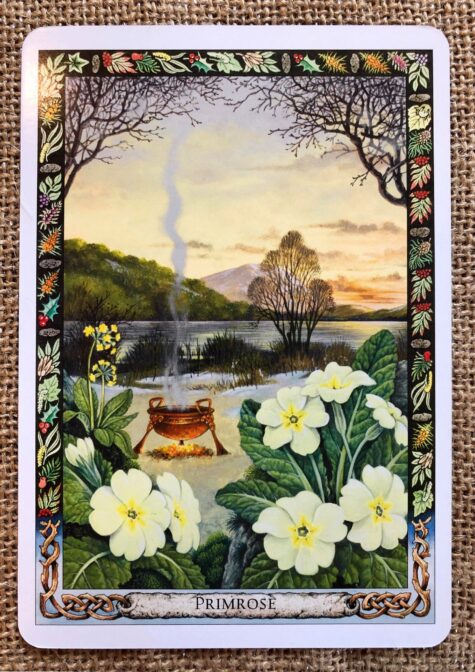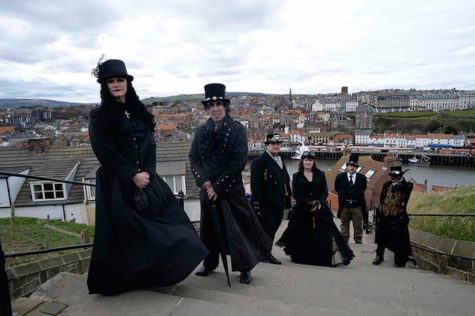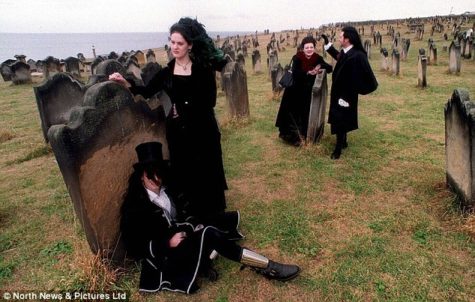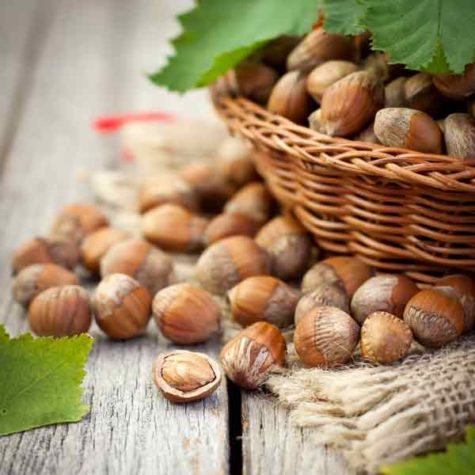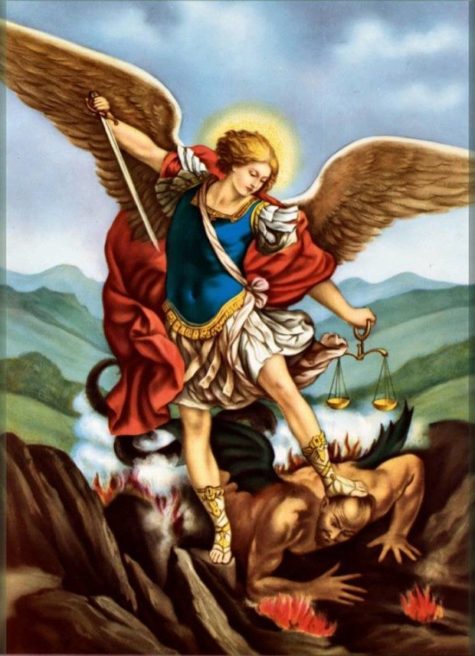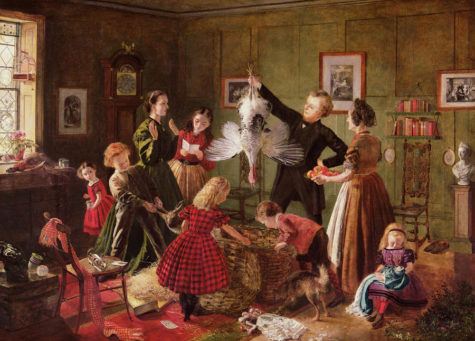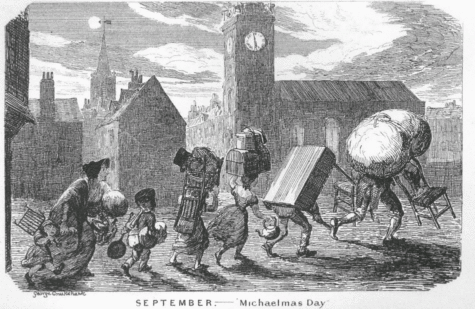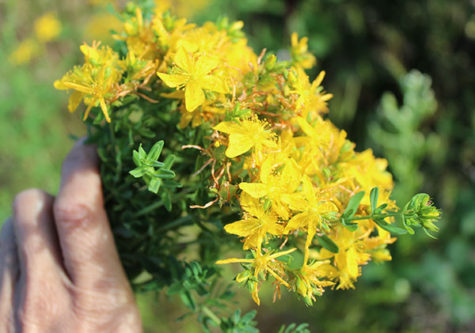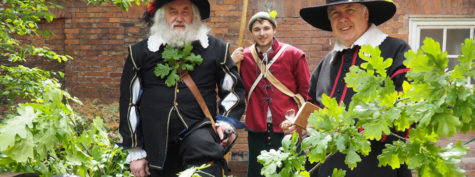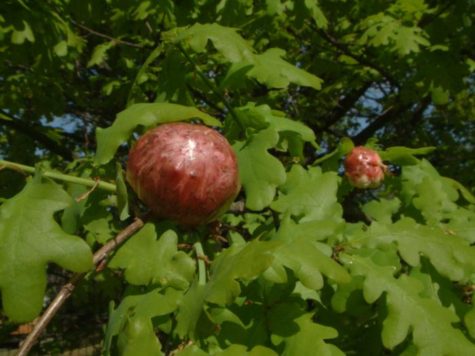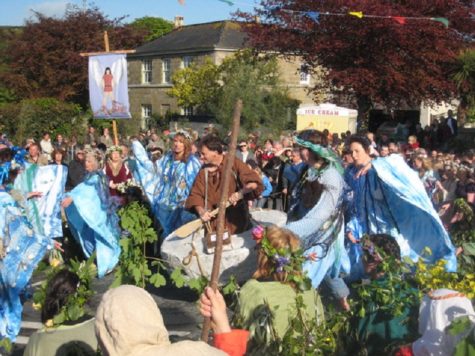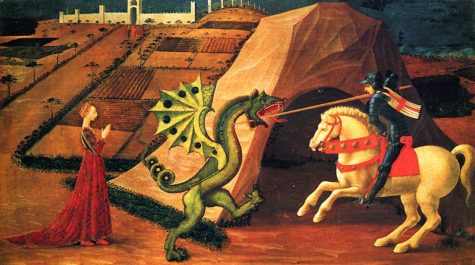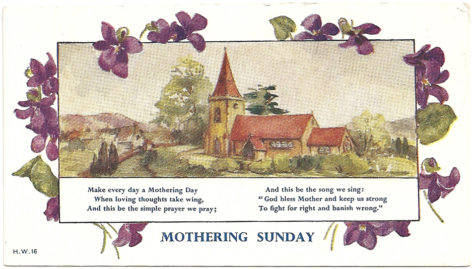England
Primrose Day is the anniversary of the death of British statesman and prime minister Benjamin Disraeli, 1st Earl of Beaconsfield, on 19 April 1881. The primrose was his favorite flower and Queen Victoria would often send him bunches of them from Windsor and Osborne House.
On this day Disraeli’s statue in Parliament Square, London is decorated with primroses, as is his grave in Hughenden, Buckinghamshire.
Often associated with the month of February, the Primrose flower symbolizes patience, kindness and gentleness. The Primrose also brings the meaning of belonging, and nurturing. Primrose is used magically as a symbol to meditate upon to draw protection and love, Oil of primrose has been used to cleanse and purify in the Druidic tradition. This wildflower is also used to symbolize the beloved guest.
Primroses attract fairies to the garden.
- To invite the fairy folk to visit and to get fairy blessings hang a spray of primroses on your door.
- Eating primroses is said to help you see fairies.
- In Ireland and Wales primroses were thought to be fairy flowers that could give the power of invisibility.
- Celtic lore says rubbing primrose flowers over your eyelids can give you a way into the fairy world.
If you grow primroses in your garden, take very good care of them. Unhealthy primroses upset the fairies and it is not recommended to have cross fairies. If kept indoors, Primroses are said to bring sickness and sorrow, perhaps this is because they generally do not grow well indoors and upset the fairies.
The pendant flowers of the cowslip, Primula veris, were sometimes called “Key Flower” in England because they were thought to resemble a hanging bunch of keys. The association with keys may also have led to another common name, “Herb Peter,” because the symbol of St. Peter is a bunch of keys. Ancient Norse peoples celebrated this primrose as a symbol of the goddess Freya, known as the “Key Virgin.”
According to the “language of flowers” Primroses symbolize youth or young love, or mean “I can’t live without you.” Lilac-tinted primroses signify confidence and red primroses symbolize unappreciated merit. In the Chakra System, it is believed that the Primrose combines the solar plexus and heart chakras.
The flowers of some primroses, especially Primula vulgaris, are edible. They can be eaten raw in salads or as an edible garnish, and can also be made into conserves (preserves). P. vulgaris flowers can be combined with yeast and sugar and fermented into wine.
In traditional herbal medicine, cowslip wine, made from P. veris, was used as a sedative. When the flowers were boiled with sugar to make a syrup, the concoction was used to treat palsy as well as nervousness. The juice of the flowers, either used alone or combined with other ingredients into an ointment, was supposed to be effective at treating facial spots and wrinkles. An old gypsy cure for skin complaints on the face: take three primrose leaves and boil them in a pint of water, drink the water.
Sources:
Whitby Goth Weekend is an alternative music festival held in Whitby. The event consists of two nights of live bands at the town’s largest venue, The Spa Pavilion, and three days of alternative trade stalls at the Spa Pavilion, Whitby Leisure Centre, and Whitby Brunswick Centre.
Dates for 2019 are as follows:
- 12-14 April
- 25-27 October
The festival was held yearly until 1997, when it became twice-yearly in April and October. It has grown into one of the world’s most popular goth music events attracting around 1,500+ attendees from across the UK and beyond. The term “Whitby Goth Weekend” is sometimes used as a generic term to describe events during the week in Whitby as a whole, although the name of the event and its associated logo are registered trademarks of Jo Hampshire of Top Mum Promotions.
The main event is held in the town’s largest venue Whitby Spa Pavilion (known as the Spa) and the Bizarre Bazaar ‘Goth Market’ is also held there and at Whitby Leisure Centre and the Brunswick Centre. Access to the Spa in the evening requires a ticket and live bands play on both Friday and Saturday from 08:00 until about midnight.
The “weekend” starts during the day on Friday and fringe events are held on Thursday, Sunday and Monday including club nights, markets, and a charity football match between visiting goth team Real Gothic, and local team Stokoemotiv Whitby.
During the October/November event there is an independent custom car show, ‘Whitby Kustom’ in the grounds of West Cliff School. There are also several “meet ups” aimed at goths with a particular interest, e.g. Lolita Goth.
Newbies who have not attended the event before are referred to as “Whitby Virgins”. To help introduce them to the event, there was a WGW Virgins Meet Up on the Friday morning at the Spa until about 2014.
In the mid-2000s the October weekend on or near Halloween began to attract large numbers of non-goths in Halloween, horror, historical, fantasy and sci-fi costume, which has led to an increase in photographers and visitors. The weekend now attracts other alternative subcultures, including Victorian vampires, rockers, punks and members of the steampunk subgenre.
Some regulars consider it no longer a purely “Goth” weekend, and it was acknowledged by Hampshire in the 2014 Whitby Goth Weekend Guide that in order to survive the event would have to diversify into other areas that have influenced Goth.
Concerns have grown about disrespect being shown to the graves in St. Mary’s Churchyard by photographers using them for photographic purposes which has resulted in a petition to have the area closed during the event, an action that Whitby Goth Weekend fully supports. The Bram Stoker Film Festival, which also took place in the town, rehashed a proposal to build a film set graveyard which photographers would be charged to use.
Sources:
Early divination was often done using only the items at hand — sticks, vegetable peels, cloud formations, etc. Around the end of the harvest season, there wasn’t often much left in the fields.
However, nuts were often plentiful. Pecans, chestnuts, filberts and more would have been gathered up in baskets and stored, which made them the perfect medium for late fall divination. This is a similar celebration to Nutting Day, which falls in mid-September.
Filberts are the European variety of hazelnuts, and in some parts of England, they were used for divination purposes around Samhain night. In fact, for a while the practice was so popular that Halloween was sometimes referred to as Nut Crack Night. Filberts were placed in a pan over a fire and roasted. As they heated up, they would pop open. Young women watched the filberts carefully, because it was believed that if they popped enough to jump out of the pan, romantic success was guaranteed.
In some areas of Europe, the nuts were not roasted, but instead were ground into flour, which was then baked into special cakes and dessert breads.
These were eaten before bed, and were said to give the sleeper some very prophetic dreams. In a few regions, the flour was blended with butter and sugar to create Soul Cakes for All Soul’s Night.
Scottish poet Robert Burns describes a practice in which couples would roast a pair of nuts together, and the behavior of the nuts was indicative of the future of the relationship.
Burns says, “Burning the nuts is a favourite charm. They name the lad and lass to each particular nut, as they lay them in the fire; and accordingly as they burn quietly together, or start from beside one another, the course and issue of the courtship will be.”
Want to do your own Nut Crack Night divination? Select a pair of uncooked filberts. Assign a name to each for you and your lover. Place them in a pan over a fire, and watch to see what they do. Nuts that fly apart indicate that the relationship won’t last, but if they stay together, you’re practically guaranteed to be happy!
by Patti Wigington, ThoughtCo.com
September 29th is a medieval holiday which the Church Christianized under the label of “Michaelmas,” a feast in honor of the Archangel Michael. It is thought that the Roman Catholic Church at some point considered assigning the quarter dates to the four Archangels, since they had assigned the cross quarters to the four gospel-writers.
The feast day of St. Michael, the archangel and overcomer of the Devil, is a Christian celebration. Its main importance in people’s lives was that of a seasonal signpost in the year. In the British Isles, crops were harvested and the surplus sold by late September, so this became the time when farmers would pay their yearly rents to landowners.
Everyone ate goose at Michaelmas to bring prosperity, and many farmers included “a goose fit for the lord’s dinner” with their rent payments. Great market fairs occurred just before the feast day, and the large crowds these attracted made it convenient to hold elections at this time. Michaelmas is also a “Quarter Day.”
The ancient Celtic people divided the year into four major sections, or quarters, and then divided each of these in half to make an eight-part year that reflected the natural progression of the seasons. Foods traditional for Michaelmas include new wine; goose; cakes of oats, barley, and rye; and carrots. Some groups in the United States, such as the Pennsylvania Dutch, have kept Michaelmas, or “Harvest Home,” traditions alive.
During the Middle Ages, Michaelmas was celebrated as a Holy Day of Obligation, but this tradition was abolished in the 18th century. Lutheran Christians consider it a principal feast of Christ.
It was also one of the Welsh and Irish quarter days when accounts had to be settled. On manors, it was the day when a reeve was elected from the peasants. Traditional meal for the day includes goose (a “stubble-goose”, i.e. one prepared around harvest time) and a special cake called a St Michael’s bannock.
A Note About Dates:
There is evidence that Michaelmas was once celebrated later in the year, on the 10th or 11th of October, this is now referred to as ‘Old Michaelmas Day’. There may also have been a time when both dates for Michaelmas were acknowledged.
I like the legend of teenage girls collecting crab apples at the beginning of September, and arranging them in the initials of boys they fancied. If they could still discern the initials on Old Michaelmas Day, then then true love and romance would follow. The legend conjures two unrelated thoughts in my mind, firstly, would other girls mischievously re-arrange the apples to form the initials of a different boy. Secondly, what is the modern equivalent of this courtship ritual?
It’s interesting that certain customs transfer from one season to another. For example, two people snapping the the Michaelmas goose’s wishbone and thinking of a secret desire. Also, the concept of a Michaelmas Pie with ring, according to this legend, the lucky recipient will be engaged by Christmas and marry by Easter. Variations on these themes occur at Christmas and possibly at Thanksgiving.
Michaelmas Customs and Lore
According to an old legend, blackberries should not be picked after this date.
This is because, so folklore goes, Satan was banished from Heaven on this day, fell into a blackberry bush and cursed the brambles as he fell into them. In Yorkshire, it is said that the devil had spat on them. This old legend is well known in all parts of the United Kingdom, even as far north as the Orkney Islands. In Cornwall, a similar legend prevails, however, the saying goes that the devil urinated on them.
This is one Michaelmas custom that survives to this day, although sometimes it is said that you should not eat blackberries after the 29th of September. There is a very good reason for this custom, namely that by this time of year blackberries are tasteless and watery.
Other fruits, particularly nuts and rose-hips also have customs associated with Michaelmas. For example, ‘Hipping Day’ in Yorkshire, or Michaelmas pie in Ireland (Made of apples).
- Mop Fairs (Hiring Time):
Michaelmas was traditionally time when laborers and servants were hired. As the name suggests, maids would carry mops, but other trades carried the tools of their trades.
Thus the squires or the lord’s of the manor could tell what skills the prospective employees had, for example, a Shepherds his crook, and a gardener a rake.
- Fishing:
Michaelmas marks the end of the fishing season.
- Curfew:
The start of the curfew for winter night nights. The local church bell sounded each night from Michaelmas until lent. Curfew is derived from the French phrase ‘courve feu’, which means to cover, or to dowse a fire.
- Rent:
When tenants came to pay their quarter’s rent, they bring a fowl at Midsummer, a dish of fish in Lent, a capon at Christmas, and on Michaelmas Day, a goose.
- Trees:
This is traditionally a good time to plant trees as evidenced by this old saying, “A Tree planted at Michaelmas, will surely not go amiss.”
More Michaelmas Lore:
At Michaelmas time, or a little before,
Half an apple goes to the core;
At Christmas time, or a little after,
A crab in the hedge, and thanks to the rafter.
- If you eat goose on Michaelmas Day, you will not be short of money all year round.
- A Michaelmas rot comes ne’er in the pot.
- If St Michael brings many acorns, Christmas will cover the fields with snow.
- Michaelmas chickens and parsons’ daughters never come to good.
- Three things that never come to any good: Christmas pigs, Michaelmas fowls, and parsons’ daughters.
- So many days the moon is old on St Michael’s day, so many floods after.
- Harvest comes as long before Michaelmas as dog roses bloom before Midsummer.
- On Michaelmas Day the devil puts his foot on the blackberries.
- St Michael’s rain does not stay long in the sky.
- If it does not rain on St Michael’s and Gallus [Oct 16], a dry spring is indicated for the next year.
Collected from a variety of sources
July 10th is Lady Godiva Day. I’m sure we’re all familiar with the story – but here it is again:
The Countess Godiva devoutly anxious to free the city of Coventry from a grievous and base thralldom often besought the Count, her husband, that he would for love of the Holy Trinity and the sacred Mother of God liberate it from such servitude. But he rebuked her for vainly demanding a thing so injurious to himself and forbade her to move further therin.
Yet she, out of her womanly pertinacity, continued to press the matter insomuch that she obtained this answer from him: “Ascend,” he said, “thy horse naked and pass thus through the city from one end to the other in sight of the people and on thy return thou shalt obtain thy request.”
Upon which she returned: “And should I be willing to do this, wilt thou give me leave?”
“I will,” he responded.
Then the Countess Godiva, beloved of God, ascended her horse, naked, loosing her long hair which clothed her entire body except her snow white legs, and having performed the journey, seen by none, returned with joy to her husband who, regarding it as a miracle, thereupon granted Coventry a Charter, confirming it with his seal.
From the Flores Historiarum by Roger of Wendover
In the English region of East Anglia, those who continue to follow the ancient ways believe that June 29 is the prime day of the year to harvest herbs for healing use.
Here are some great tips for harvesting herbs:
For the highest quality, herbs should be harvested before the Sun gets too high in the sky. The heat of the Sun will evaporate the essential oil from the herbs, so picking earlier in the day (like by 10:30am) ensures that the highest amount of oils will still be present within them.
When getting plants from the wild, respect the area and plant you are harvesting, never strip a plant bare, never pull it out by the roots to get a few leaves and I always check to see that there are other plants of the same species around and its not some rare almost extinct plant. Also be very sure that the plant you are about to pick is what you think it is, Mother Nature can be very tricky sometimes, and 2 seemingly identical plants can have very different effects when ingested. It is best to ask permission of the plant before taking it’s bounty, and remember, respect, respect, respect!
Transporting your herbs must be done carefully to retain their valuable powers. It’s best to take an open-topped basket or cotton bag with you and some layers of tissue so that herbs can be transported dry and safe back to home, it is pointless seeking out a special plant, than sticking it into a carrier bag in your pocket so it sweats, bruises and it unidentifiable mush by the time you get home.
It is best not to harvest any herbs that have been growing close to the road as the leaves take in the carbon monoxide and poisonous fumes given out by the traffic and take it down into the plant to the root where it becomes stored. Do not pick wild herbs and plants from verges or thoroughfares as this contravenes several laws and also the fact that most areas like these are open to our friendly dog and cat population.
If harvesting wild plants leave a large amount of flowers, seed and root as the plant population of that area will very quickly die out if you go in mob-handed and wrench up the only two plants for miles around.
To harvest herbs in a magickal way visit this post: Harvesting Magickal Herbs in a Magickal Way
Oak Apple Day or Royal Oak Day was a formal public holiday celebrated in England on 29 May to commemorate the restoration of the English monarchy, in May 1660. Parliament declared this to be a public holiday, “to be for ever kept as a day of thanksgiving for our redemption from tyranny and the King’s return to his Government, he entering London that day.”
People wore sprigs of oak and decorated homes, boats, barns and (latterly) even railway engines. There was dancing, maypoles, and the streets were hung with oak branches. Anyone who failed to wear a sprig of oak risked being pelted with bird’s eggs or thrashed with nettles. In Sussex, those not wearing oak were liable to be pinched, giving rise to the unofficial name of “Pinch-bum Day”; similarly it was known as “Bumping Day” in Essex.
The Chelsea Pensioners still wear oak leaves on their Founders Day (which is always as close as possible to 29th May) as the Royal Hospital of Chelsea was founded by Charles II. They also decorate the statue of Charles II there with oak leaves and branches.
In Upton Grey, Hampshire, after the church bells had been rung at 6 a.m. the bell-ringers used to place a large branch of oak over the church porch, and another over the lych gate. Smaller branches were positioned in the gateway of every house to ensure good luck for the rest of the year.
These ceremonies, which have now largely died out, are perhaps continuations of pre-Christian nature worship.
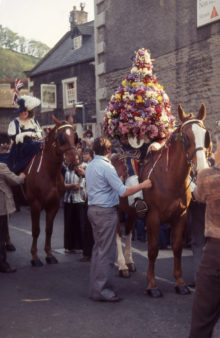 The Garland King who rides through the streets of Castleton, Derbyshire, at the head of a procession, completely disguised in a garland of flowers which is later affixed to a pinnacle on the parish church tower, can have little connection with the Restoration, even though he dresses in Stuart costume.
The Garland King who rides through the streets of Castleton, Derbyshire, at the head of a procession, completely disguised in a garland of flowers which is later affixed to a pinnacle on the parish church tower, can have little connection with the Restoration, even though he dresses in Stuart costume.
He is perhaps a kind of Jack in the Green and the custom may have transferred from May Day when such celebrations were permitted again after having been banned by the Puritans.
The public holiday, Oak Apple Day, was formally abolished by the Anniversary Days Observance Act 1859, but the date retains some significance in local or institutional customs.
Events still take place at Upton-upon-Severn in Worcestershire, Aston on Clun in Shropshire, Marsh Gibbon in Buckinghamshire, Great Wishford in Wiltshire (when villagers gather wood in Grovely Wood), and Membury in Devon. The day is generally marked by re-enactment activities at Moseley Old Hall, West Midlands, one of the houses where Charles II hid in 1651.
Fownhope, Hereford have an ongoing tradition in the celebration of Oak Apple Day. The Fownhope Heart of Oak Society organize an annual event, where members of the society gather at the local pub and march through the village holding flower and oak leaf decorated sticks, whilst following the society banner and a brass band. The march goes first to the church for a service, and then to houses who host refreshments.
The Heart of Oak Society was previously a friendly society, but had to reform in 1989 to keep the tradition going. Although Oak Apple Day celebrations have decreased in popularity and knowledge, Fownhope has managed to keep the event going, increasing in popularity and turn-out every year.
At All Saints’ Church, Northampton a statue of Charles II is wreathed at noon every Oak Apple Day, followed by a celebration of the Holy Communion according to the Book of Common Prayer.
At some Oxford and Cambridge colleges a toast is still drunk to celebrate Oak Apple Day.
Oak Apple Day is also celebrated in the Cornish village of St Neot annually. The Vicar leads a procession through the village, he is followed by the Tower Captain holding the Oak bough. A large number of the villagers follow walking to the Church. A story of the history of the event is told and then the Vicar blesses the branch. The Tower Captain throws the old branch down from the top of the tower and a new one is hauled to the top.
Everyone is then invited to the vicarage gardens for refreshments and a barbecue. Up to 12 noon villagers wear a sprig of “red” (new) oak and in the afternoon wear a sprig of “Boys Love” (Artemisia abrotanum); tradition dictates that the punishment for not doing this results in being stung by nettles.
What is an Oak Apple?
An oak apple is a mutation of an oak leaf caused by chemicals injected by the larvae of certain kinds of gall wasp laying an egg which becomes a larva inside the gall. In some parts of the country it is known as a “shick-shack.”
Oak apples (or galls) were also used to divine the future or to check if a child had been bewitched. Some of the meanings of what was found inside are as follows:
- An ant – plenty of grain to come
- A spider – ‘pestilence among men’
- A white worm or maggot – ‘murain of beasts’
- A flying worm – war
- A creeping worm – a scarce harvest
- A turning worm – plague
People would also wear oak bark and galls woven into balls as healing charms.
Source: Wikipedia
The Furry Dance, also known as The Flora (or incorrectly as the Floral Dance), takes place in Helston, Cornwall, and is one of the oldest British customs still practiced today. The Dance takes place every year on May 8 (or the Saturday before if May 8 falls on a Sunday or Monday), and is a celebration of the passing of Winter and the arrival of Spring.
The dance is very well attended every year. Winter’s gone, so everybody’s out in the streets to celebrate the new life springing up all around. It seems like the whole of Cornwall is lining the streets, all freshly decorated with colourful flowers
The four dances and a Hal-an-Tow (a mystery play), spread across the day, starting with the first dance at 7.00 am, continuing with the children’s dance at 10.00 am, then the midday dance and culminating in the evening dance at 5.00 pm. Of these, the midday dance is perhaps the best known: it was traditionally the dance of the gentry in the town, and today the men wear top hats and tails while the women dance in their finest frocks.
The Dance twists and turns its way through this ancient Cornish town and the route doesn’t change, even if that means that the Flora Dance has to traipse through people’s houses, across their gardens or straight through the shops.
The whole town is decorated with greenery, many of the people are wearing greenery outfits and the Town Band play all day long, providing music to the dancers, they have a splash of greenery in their hats too, you’ll notice this is Lily of the Valley, which is Helston’s symbolic flower. The gentlemen wear it on the left, with the flowers pointing upwards, and the ladies wear it upside down on the right.
Originally, most likely, a May Day celebration, it was moved to May 8th to commemorate the town’s patron saint, St Michael, who is said to have saved the town from what appears to be a meteorite hit in AD 495, you can still see the boulder that crashed down as it’s still visible as a wall in the Angel Yard.
Source: Cornish Festivals
Have Your Own Furry Dance:
The Furry Dance is an ancient festival that rejoices in spring’s warmth and beauty. To bring this energy into your life, it’s customary to dance with a partner. In fact, the more people you can get dancing, the more fortunate the energy! Usually this is done on the streets throughout a town as a show of regional unity, but when propriety won’t allow such a display, just dance around a room together instead. Don’t worry about the steps – just do what feels right.
- Themes: Unity; Joy; Luck
- Symbols: Flowers; Triangle
- Presiding Goddess: Tanat
In Cornwall, Tanat is the mother goddess of fertility who has given all her attention to nursing spring into its fullness. She also staunchly protects her children (nature and people) so that our spirits can come to know similar fulfillment.
Wearing something with floral or triangular motifs (guys, wear a necktie, and gals, pull out a square scarf and fold it crosswise) activates Tanat’s happiness in your life and in any region where you have the token on today. As you don the item, say:
Liberate happiness in and around,
by Tanat’s blossoming power, joy will be found!
Or if you want to use the same thing to generate unity and harmony, use this incantation:
Harmony and unity,
Tanat’s blessings come to me.
From: 365 Goddess
Saint George’s Day is celebrated on April 23, the traditionally accepted date of the saint’s death in AD 303. For those Eastern Orthodox Churches which use the Julian calendar, this date currently falls on the day of 6 May of the Gregorian calendar. In Turkish culture the day is known as Hıdırellez or Xıdır Nəbi and is symbolic of spring renewal.
It is also believed to be a magical day when all evil spells can be broken. It was believed that the saint helps the crops to grow and blesses the morning dew, so early in the morning they walked in the pastures and meadows and collected dew, washed their face, hands and feet in it for good luck and even in some rural parts of Bulgaria it was a custom to roll in it naked.
In Romania, people celebrate St. George – ‘Sfantul Gheorghe’ – and in certain regions, including Bucovina, people will still plant cut willow branches in freshly cut earth and place them at the entrances to their homes.
Many Christian denominations in Syria celebrate St George’s Day, especially in the Homs Governorate. They do this by dressing small children as dragons and chasing them through the streets whilst beating them with clubs and batons. It is a very special time of year, after the beatings folks will enjoy a sit down dinner and dancing.
Saint George’s Day is the feast day of Saint George as celebrated by various Christian Churches and by the several nations, kingdoms, countries, and cities of which Saint George is the patron saint.
Since Easter often falls close to Saint George’s Day, the church celebration of the feast may be moved to accommodate the Easter Festivities. Similarly, the Eastern Orthodox celebration of the feast moves accordingly to the first Monday after Easter or, as it is sometimes called, to the Monday of Bright Week.
Some Orthodox Churches have additional feasts dedicated to St George. The country of Georgia celebrates the feast of St. George on April 23, and, more prominently, November 10 (Julian calendar), which currently fall on May 6 and November 23 (Gregorian calendar), respectively.
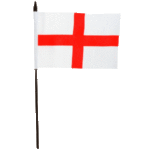 St George’s Day was a major feast and national holiday in England on a par with Christmas from the early 15th century. The Cross of St. George was flown in 1497 by John Cabot on his voyage to discover Newfoundland and later by Sir Francis Drake and Sir Walter Raleigh. In 1620 it was the flag that was flown on the foremast of the Mayflower when the Pilgrim Fathers arrived in Plymouth, Massachusetts.
St George’s Day was a major feast and national holiday in England on a par with Christmas from the early 15th century. The Cross of St. George was flown in 1497 by John Cabot on his voyage to discover Newfoundland and later by Sir Francis Drake and Sir Walter Raleigh. In 1620 it was the flag that was flown on the foremast of the Mayflower when the Pilgrim Fathers arrived in Plymouth, Massachusetts.
The tradition of celebration St George’s day had waned by the end of the 18th century after the union of England and Scotland. Nevertheless, the link with St. George continues today, for example Salisbury holds an annual St. George’s Day pageant, the origins of which are believed to go back to the 13th century. In recent years the popularity of St. George’s Day appears to be increasing gradually. Today, St. George’s day may be celebrated with anything English including morris dancing and Punch and Judy shows.
A traditional custom on St George’s day is to wear a red rose in one’s lapel, though this is no longer widely practiced. Another custom is to fly or adorn the St George’s Cross flag in some way: pubs in particular can be seen on April 23 festooned with garlands of St George’s crosses. It is customary for the hymn “Jerusalem” to be sung in cathedrals, churches and chapels on St George’s Day, or on the Sunday closest to it. Traditional English food and drink may be consumed.
In the Valencian city of Alcoi, Saint George’s Day is commemorated as a thanksgiving celebration for the proclaimed aid the Saint provided to the Christian troops fighting the Muslims in the siege of the city. Its citizens commemorate the day with a festivity in which thousands of people parade in medieval costumes, forming two “armies” of Moors and Christians and re-enacting the siege that gave the city to the Christians.
The Serbian St George’s Day is called Đurđevdan and is celebrated on 6 May every year, as the Serbian Orthodox Church uses the Julian, Old Style calendar. Đurđevdan is also celebrated by both Orthodox and Muslim Romani and Muslim Gorani. Đurđevdan is celebrated, especially, in the areas of Raška in Serbia, and is marked by morning picnics, music, and folk dances.
In Russia, St George’s Day (Гергьовден, Gergyovden) is a public holiday that takes place on 6 May each year. It is possibly the most celebrated name day in the country. A common ritual is to prepare and eat a whole lamb, which is an ancient practice possibly related to Slavic pagan sacrificial traditions and the fact that St George is the patron saint of shepherds.
A Protective Blessing Ritual for Saint George’s Day:
In many communities, Saint George’s Day was the day animals were lead out into the field, thus protective, blessing rituals abound. Here’s one:
- Lead all healthy animals three times around the perimeter of their field, barn or home, always in a sunwise direction.
- The person leading the parade carries a lit torch.
- The person bringing up the rear holds an open padlock in one hand, the key in the other hand.
- After the third round, the animals are lead back into the barn.
- Turn the key in the lock.
- Throw the key into a river or stream, while preserving the now permanently locked padlock.
Dragons and Dragon’s Blood:
St. George is credited with having slain a fearsome dragon to save the life of a virgin. The Dragon means different things to different peoples. In some medieval traditions it is linked with the devil or Satan, hence the carvings and windows depicting St George, (or sometimes St Michael), slaying one.
But the Dragon has far older associations in which it represents the life force of the land. In the Craft we often refer to the Earth Dragon, a great coiled beast who sleeps within the Earth and who can be called upon to work healing for the planet. The Earth Dragon is often invoked in cases of potential ecological danger. King Arthur’s father was named Uther Pendragon, and it is thought that his name shows that he was a defender of the land. The Dragon is a symbol of Wales and appears on the country’s flag.
Dragon’s blood is not the blood of some luckless lizard, but the resin of the palm calimus draco. Magically it is used for spells of protection, exorcism and sexual potency. Added to incenses it increases their potency and drives away all negativity. On its own Dragon’s blood can be burnt at an open window to secure a lover’s return, and a piece of the resin placed under the mattress is said to cure impotence. In the past Dragon’s Blood was used medicinally to cure diarrhoea, dysentery and even syphilis. Like many other resins it is also used to stop bleeding wounds.
Sources:
Mothering Sunday is a holiday celebrated by Catholic and Protestant Christians in some parts of Europe. It falls on the fourth Sunday in Lent, exactly three weeks before Easter.
The other names attributed to the fourth Sunday in Lent include:
- Refreshment Sunday
- Pudding Pie Sunday (in Surrey, England)
- Mid-Lent Sunday
- Simnel Sunday
- Rose Sunday
Simnel Sunday is named after the practice of baking simnel cakes to celebrate the reuniting of families during the austerity of Lent. (Here is a recipe: Simnel Cake.) Because there is traditionally a relaxation of Lenten vows on this particular Sunday in celebration of the fellowship of family and church, the name Refreshment Sunday is sometimes used, although rarely today.
Simnel cake is a traditional confection associated with both Mothering Sunday and Easter. Around 1600, when the celebration was only held in England and Scotland, a different kind of pastry was preferred. In England, “Mothering Buns” or “Mothering Sunday Buns” were made to celebrate. These sweet buns are topped with pink or white icing and the multi-colored sprinkles known as “hundreds and thousands” in the UK. (Here’s a recipe: Mothering Buns). They are not widely made or served today in the UK but in Australia they are a bakery staple, not related to any particular celebration. In Northern England and Scotland some preferred “Carlings”, pancakes made of steeped peas fried in butter.
It is sometimes said that Mothering Sunday was once observed as a day on which people would visit their “mother” church. During the 16th century, people returned to their mother church, the main church or cathedral of the area, for a service to be held on Laetare Sunday. This was either the church where they were baptized, or the local parish church, or more often the nearest cathedral.
Anyone who did this was commonly said to have gone “a-mothering”, although whether this term preceded the observance of Mothering Sunday is unclear. In later times, Mothering Sunday became a day when domestic servants were given a day off to visit their mother church, usually with their own mothers and other family members. The children would pick wild flowers along the way to place in the church or give to their mothers. Eventually, the religious tradition evolved into the Mothering Sunday secular tradition of giving gifts to mothers.
It was often the only time that whole families could gather together, since on other days they were prevented by conflicting working hours, and servants were not given free days on other occasions.
Whatever its origins, it is now an occasion for honoring the mothers of children and giving them presents. It is increasingly being called Mothers’ Day, although that has always been a secular event quite different from the original Mothering Sunday. In the UK and Ireland, Mothering Sunday is celebrated in the same way as Mothers’ Day is celebrated elsewhere.
By the 1920’s the custom of keeping Mothering Sunday had tended to lapse in Ireland and in continental Europe. In 1914, inspired by Anna Jarvis’s efforts in the United States, Constance Penswick-Smith created the Mothering Sunday Movement, and in 1921 she wrote a book asking for the revival of the festival.
Its wide scale revival was through the influence of American and Canadian soldiers serving abroad during World War II; the traditions of Mothering Sunday, still practiced by the Church of England and Church of Ireland were merged with the newly imported traditions and celebrated in the wider Catholic and secular society. UK-based merchants saw the commercial opportunity in the holiday and relentlessly promoted it in the UK; by the 1950’s, it was celebrated across all the UK.
People from Ireland and the UK started celebrating Mothers’ Day on the same day that Mothering Sunday was celebrated, the fourth Sunday in Lent. The two celebrations have now been mixed up, and many people think that they are the same thing.
Mothering Sunday remains in the calendar of some Canadian Anglican churches, particularly those with strong English connections.
Found at: Wikipedia
